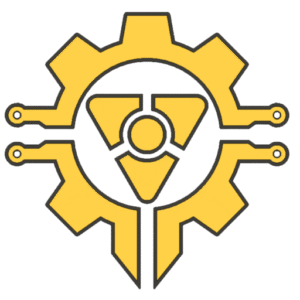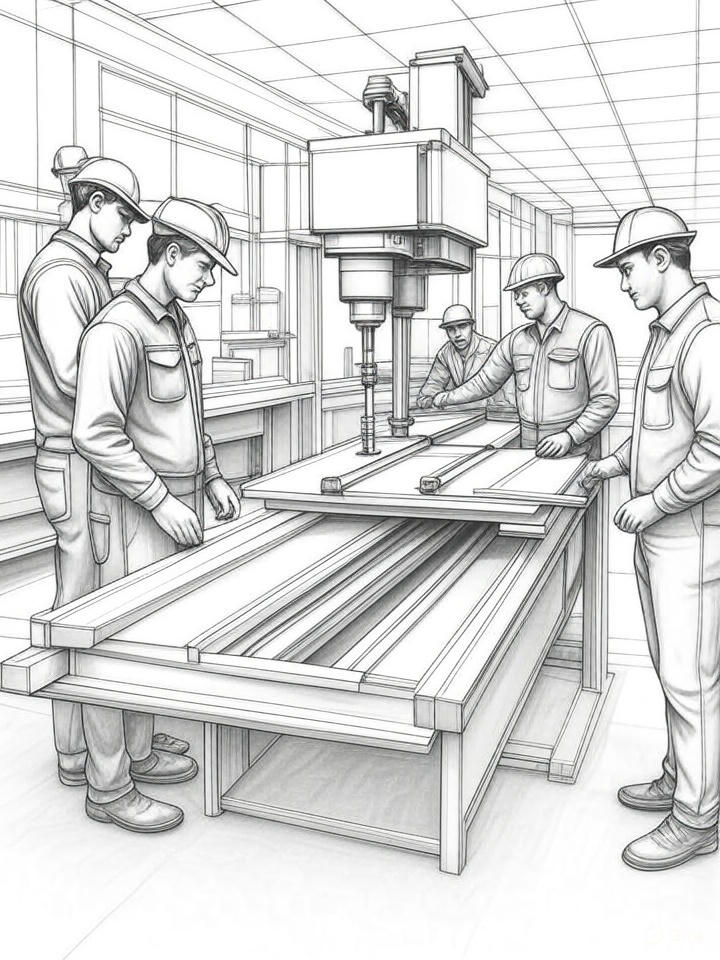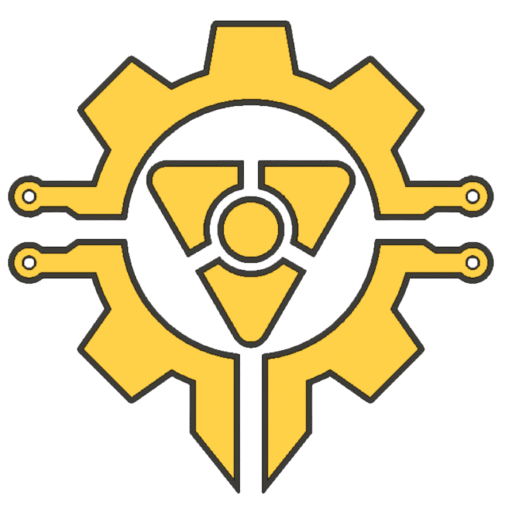Introduction to CNC Machining
In the competitive landscape of modern manufacturing, precision, efficiency, and speed are critical for success. Computer Numerical Control (CNC) machining has emerged as a cornerstone technology, enabling businesses to transform concepts into tangible, high-quality products with remarkable accuracy. At Warning Machines, an engineer-run prototyping and low-volume manufacturing studio, we leverage advanced CNC technology to convert your ideas, whether sketched on a napkin or detailed in CAD files, into fully functional, production-ready hardware in 30 days or less.
This comprehensive guide explores the fundamentals of CNC machining, its benefits, applications, and why it is the preferred choice for businesses seeking reliable manufacturing solutions. Focusing on timeless aspects of CNC technology, this article aims to provide enduring value for C-level executives and businesses evaluating manufacturing options.
CNC machining is a subtractive manufacturing process where computer-controlled tools remove material from a workpiece to create precise components. Unlike manual machining, which relies on human operators, CNC systems use pre-programmed software, typically G-code and M-code, to dictate tool movements, speeds, and other parameters. This automation ensures consistent, repeatable results, making CNC machining indispensable for industries requiring high precision, such as aerospace, automotive, and medical device manufacturing. The global CNC machine market is experiencing significant growth, driven by increasing demand for automation and precision, underscoring its critical role in modern production environments.
What is CNC Machining?
CNC, or Computer Numerical Control machining, involves using computer software to control machine tools, such as lathes, mills, routers, and grinders, to fabricate parts from raw materials. The process begins with a digital design, typically created using Computer-Aided Design (CAD) software, which is then translated into machine instructions via Computer-Aided Manufacturing (CAM) software. These instructions, encoded in G-code, specify the exact movements, speeds, and tool paths required to shape the workpiece.
The evolution of CNC machining has revolutionized manufacturing since its inception in the mid-20th century. Initially developed as numerical control (NC) systems using punched cards, CNC technology advanced with the integration of computers in the 1960s, enabling greater flexibility and precision. Today, CNC machines can produce complex geometries with tolerances as tight as ±0.001 inches, making them essential for applications where accuracy is paramount. At Warning Machines, our state-of-the-art CNC equipment ensures that your designs are executed with the highest standards of quality and efficiency.
Key Components of CNC Machining
-
CAD Software: Used to create detailed digital models of the desired part.
-
CAM Software: Converts CAD models into machine-readable instructions (G-code).
-
CNC Machine: Executes the programmed instructions to shape the workpiece.
-
Workpiece Materials: Includes metals (e.g., aluminum, steel, titanium), plastics (e.g., ABS, polycarbonate), and composites.
-
Quality Control Systems: Ensures parts meet specified tolerances through precise measurement tools.
Benefits of CNC Machining for Businesses
CNC machining offers many advantages, making it an attractive option for businesses, particularly those focused on prototyping and low-volume production. Below, we outline the key benefits, tailored to the needs of C-level executives seeking efficient, cost-effective manufacturing solutions.
1. Unmatched Precision and Accuracy
CNC machines deliver exceptional precision, producing parts with tolerances as tight as ±0.001 inches. This level of accuracy is critical for industries such as aerospace and medical, where even minor deviations can compromise safety or performance. For example, CNC machining ensures that aircraft components or surgical instruments meet stringent specifications, reducing the risk of failure in critical applications.
2. Consistency and Repeatability
One of the standout features of CNC machining is its ability to produce identical parts repeatedly. This consistency is vital for businesses requiring uniform components, ensuring that every part meets the same high standards. This repeatability enhances product quality and customer satisfaction, making CNC machining ideal for prototyping and production runs.
3. Speed and Efficiency
Automation in CNC machining significantly reduces production times compared to manual methods. Machines can operate 24/7 with minimal human intervention, accelerating project timelines and enabling faster market entry. For businesses, this translates to reduced lead times and the ability to respond quickly to market demands.
4. Flexibility in Design and Materials
CNC machining supports various materials, including metals (aluminum, steel, titanium), plastics (ABS, polycarbonate, PEEK), and composites. This versatility allows businesses to select materials that best suit their application, whether for strength, weight, or corrosion resistance. Additionally, CNC machines can handle complex geometries, enabling rapid design iterations without significant cost increases.
5. Cost-Effectiveness for Prototyping and Low-Volume Production
Unlike injection molding, which requires expensive tooling, CNC machining eliminates the need for costly molds, making it cost-effective for small batches. This is particularly beneficial for prototyping, where design changes are common, and for low-volume production, where flexibility and quick turnaround are prioritized.
6. Enhanced Safety
By automating the machining process, CNC systems reduce the need for human operators to interact directly with cutting tools, improving workplace safety. This automation also minimizes human error, ensuring consistent quality and reducing the risk of costly mistakes.
7. Scalability and Versatility
CNC machining is suitable for both small-scale prototyping and larger production runs. Its ability to produce high-quality parts in varying quantities makes it a versatile solution for businesses at different stages of product development, from initial concept to market launch.
8. Reduced Material Waste
CNC machining optimizes material usage through precise cutting paths, minimizing waste compared to traditional methods like casting or stamping. This efficiency lowers material costs and aligns with sustainable manufacturing practices.
|
Benefit |
Description |
Business Impact |
|---|---|---|
|
Precision and Accuracy |
Tolerances as tight as ±0.001 inches for critical applications. |
Ensures high-quality parts for industries like aerospace and medical. |
|
Consistency |
Produces identical parts repeatedly. |
Enhances product reliability and customer satisfaction. |
|
Speed and Efficiency |
Automated processes reduce production times. |
Accelerates time to market, critical for competitive industries. |
|
Flexibility |
Handles complex designs and various materials. |
Supports rapid design iterations and diverse applications. |
|
Cost-Effectiveness |
No need for expensive tooling for small batches. |
Reduces upfront costs for prototyping and low-volume production. |
|
Safety |
Minimizes human intervention in machining processes. |
Improves workplace safety and reduces errors. |
|
Scalability |
Suitable for small to large production runs. |
Adapts to varying production needs, from prototypes to full-scale manufacturing. |
|
Reduced Waste |
Precise cutting minimizes material waste. |
Lowers costs and supports sustainable practices. |
Types of CNC Machines and Their Applications
CNC machining encompasses a variety of machine types, each designed for specific tasks and materials. Understanding these machines helps businesses select the right equipment for their needs. Below are the primary types of CNC machines used at Warning Machines and their applications.
1. CNC Milling Machines
CNC milling machines use rotary cutting tools to remove material from a workpiece, capable of performing operations like face milling, drilling, and tapping. They are ideal for creating complex geometries and are widely used in industries such as aerospace and automotive for parts like engine components and structural elements .
2. CNC Lathes
CNC lathes rotate the workpiece against a stationary cutting tool, making them suitable for producing cylindrical parts such as shafts, bolts, and fittings. Their precision and efficiency make them essential for rotational symmetry applications.
3. CNC Routers
Similar to milling machines, CNC routers are typically used for softer materials like wood, plastics, and composites. They are common in furniture manufacturing and prototyping industries, where intricate designs are needed .
4. CNC Plasma Cutters
CNC plasma cutters use a plasma torch to cut through conductive materials like steel and aluminum. They are often used in metal fabrication to create large, flat components with high precision.
5. CNC Laser Cutters
CNC laser cutters employ a laser beam to cut or engrave materials, offering exceptional precision for thin materials. They are used in industries like electronics to create intricate and decorative components.
6. CNC Electric Discharge Machines (EDM)
EDM machines use electrical discharges to shape hard metals that are difficult to machine with traditional methods. They are ideal for creating precise molds and dies in aerospace and tool manufacturing.
|
CNC Machine Type |
Primary Function |
Common Applications |
Materials |
|---|---|---|---|
|
Milling Machines |
Cutting, drilling, and shaping complex parts |
Engine components, structural parts |
Metals, plastics, Juno |
|
Rapid prototyping is critical in product development, allowing businesses to test and refine designs before full-scale production. CNC machining is an ideal choice for prototyping due to its speed, precision, and material versatility. Below, we explore how Warning Machines leverages CNC technology to deliver high-quality prototypes. |
Advantages of CNC Machining for Prototyping
-
Speed: CNC machines produce prototypes quickly, often within days, enabling rapid design iterations.
-
Precision: Prototypes match the exact specifications of the final product, ensuring accurate testing of fit and function.
-
Material Versatility: Prototypes from production-grade materials can provide realistic performance data.
-
Complex Geometries: CNC machines handle intricate designs that other methods, like 3D printing, may struggle with.
-
Cost-Effectiveness: No need for expensive molds, making it economical for small batches.
The Prototyping Process at Warning Machines
At Warning Machines, our prototyping process begins with a collaborative design review, during which our engineers refine your sketches or CAD files for manufacturability. We then generate precise G-code instructions for our CNC machines using advanced CAM software. The selected material is machined with high accuracy, followed by rigorous quality checks to ensure compliance with specifications. This streamlined process allows us to deliver functional prototypes in 30 days or less, enabling you to test and refine your designs efficiently.
CNC Machining for Low-Volume Production
Low-volume production, typically ranging from 10 to 10,000 units, is ideal for businesses testing market demand, producing limited-edition products, or bridging the gap between prototyping and mass production. CNC machining excels in this area due to its flexibility and cost-effectiveness.
Benefits of CNC Machining for Low-Volume Production
-
Cost-Effective: Eliminates the need for expensive tooling, reducing upfront costs.
-
Flexibility: Easy to implement design changes without significant cost increases.
-
Speed: Rapid setup and production times ensure quick delivery.
-
Quality: High precision and consistency ensure production-grade quality.
-
Customization: Supports mass customization for unique specifications.
Low-Volume Production at Warning Machines
Our low-volume production services are tailored to meet the needs of businesses requiring small to medium quantities of parts. Using advanced CNC machines, we produce high-quality components with minimal setup times, ensuring cost-effective and timely delivery. Our in-house capabilities allow us to maintain strict quality control, delivering parts that meet your requirements.
Industries That Rely on CNC Machining
CNC machining serves various industries, each benefiting from its precision and versatility. Below are some key sectors that rely on CNC technology.
1. Aerospace
CNC machining produces critical components like turbine blades and landing gear, meeting stringent safety and performance standards.
2. Automotive
From engine parts to custom modifications, CNC machining supports the production of high-performance automotive components.
3. Medical
CNC technology creates precise surgical instruments, implants, and diagnostic equipment that comply with medical regulations.
4. Electronics
CNC machining manufactures enclosures, heat sinks, and connectors for compact, high-performance electronic devices
5. Defense
CNC machines produce reliable parts for weaponry, vehicles, and communication systems, ensuring durability in demanding conditions.
6. Oil and Gas
Valves, pumps, and drilling equipment are crafted with CNC machining for robust performance in harsh environments.
7. Marine
CNC machining supports the production of propellers, hull components, and other marine parts requiring corrosion resistance.
|
Industry |
Applications |
Benefits |
|---|---|---|
|
Aerospace |
Turbine blades, structural components |
High precision, lightweight materials |
|
Automotive |
Engine parts, transmission components |
Durability, customization |
|
Medical |
Surgical instruments, implants |
Regulatory compliance, precision |
|
Electronics |
Enclosures, connectors |
Compact designs, high performance |
|
Defense |
Weaponry, communication devices |
Reliability, durability |
|
Oil and Gas |
Valves, drilling equipment |
Robustness, corrosion resistance |
|
Marine |
Propellers, hull components |
Corrosion resistance, strength |
The CNC Machining Process at Warning Machines
Our comprehensive CNC machining process ensures your project moves seamlessly from concept to completion. Below is an overview of our process:
-
Design Consultation: Our engineers collaborate with you to optimize your design for manufacturability, refining sketches or CAD files as needed.
-
Programming: Using advanced CAM software, we generate precise G-code instructions to guide our CNC machines.
-
Material Selection: We select the optimal material based on your project’s requirements, from aluminum to engineering plastics.
-
Machining: Our state-of-the-art CNC machines execute the programmed instructions with high precision.
-
Quality Control: Rigorous inspections using advanced measurement tools ensure compliance with specifications.
-
Finishing: Post-processing options, such as polishing or coating, enhance the part’s functionality and appearance.
-
Assembly and Delivery: If required, parts are assembled into larger components and delivered within 30 days.
This integrated approach, conducted under one roof, ensures efficient communication, rapid turnaround, and exceptional quality.
Why Choose Warning Machines for Your CNC Machining Needs
Warning Machines is your trusted partner for CNC machining, offering a unique combination of engineering expertise, advanced technology, and customer-focused service. Our engineer-run studio is equipped with cutting-edge CNC machines capable of efficiently handling complex designs, including 5-axis milling centers and precision lathes. We provide end-to-end solutions, from design optimization to final production, all under one roof, ensuring seamless project execution and rapid delivery within 30 days. Our commitment to quality, flexibility, and speed makes us the ideal choice for businesses seeking reliable prototyping and low-volume manufacturing solutions.
Choosing the Right Manufacturing Method
CNC machining is one of several manufacturing technologies available, each with its strengths. Below, we compare CNC machining with 3D printing and injection molding to help you make informed decisions.
CNC-Machining vs 3D Printing
-
CNC Machining offers superior precision, strength, and surface finish. It is ideal for functional prototypes and production parts from metals and engineering plastics. It best suits applications requiring tight tolerances and durability.
-
3D Printing is faster for complex geometries and has a lower cost for very small quantities, but it is limited by material strength and surface quality. It is ideal for visual prototypes and rapid design iterations.
CNC Machining vs. Injection Molding
-
CNC Machining requires no molds, making it cost-effective for low-volume production and prototyping. It also offers flexibility for design changes and quick turnaround.
-
Due to economies of scale, Injection Molding is more cost-effective for high-volume production, but it requires significant upfront investment in tooling, making it less suitable for small batches.
For prototyping and low-volume production, CNC machining is often the preferred choice due to its balance of precision, flexibility, and cost-effectiveness.

Frequently Asked Questions
-
What is the difference between CNC machining and traditional machining?
CNC machining uses computer-controlled tools for precise, automated production, while traditional machining relies on manual operation, which is less accurate and more time-consuming. -
How long does it take to produce a part with CNC machining?
Production times vary based on complexity and quantity, but Warning Machines delivers parts within 30 days or less, ensuring rapid turnaround. -
What materials can be used in CNC machining?
CNC machining supports various materials, including metals (aluminum, steel, titanium), plastics (ABS, polycarbonate, PEEK), and composites. -
Is CNC machining suitable for large production runs?
While ideal for prototyping and low-volume production, CNC machining can support larger runs when high precision is required. For very large volumes, injection molding may be more cost-effective. -
How do I get started with Warning Machines?
Contact us with your design files or ideas, and our team will guide you through the process, from design optimization to final production.
Conclusion
CNC machining is a versatile, precise, and efficient manufacturing technology that empowers businesses to bring innovative products to market quickly and cost-effectively. Its ability to produce high-quality prototypes and low-volume parts makes it an essential tool for the aerospace and medical industries. At Warning Machines, we combine advanced CNC technology with engineering expertise to deliver fully functional, production-ready hardware in 30 days or less. Our integrated, in-house approach ensures seamless project execution and exceptional quality, helping you stay ahead in a competitive market. Contact Warning Machines today to discover how we can transform your concepts into reality. If you are interested in CNC manufacturing, we suggest you read our blog’s World-Class CNC Machining & Rapid Prototyping article.




